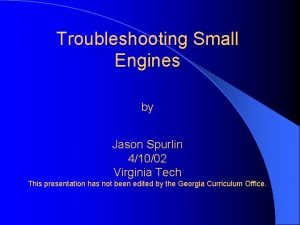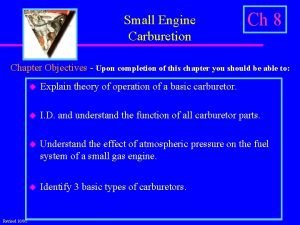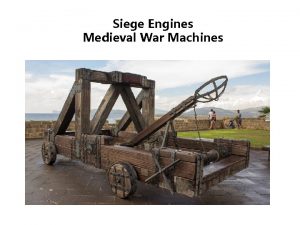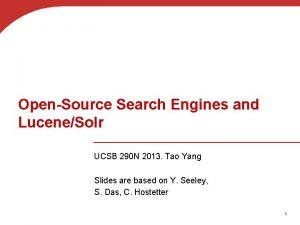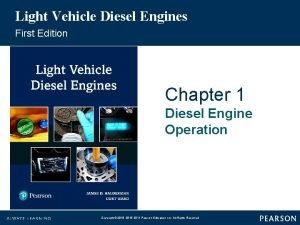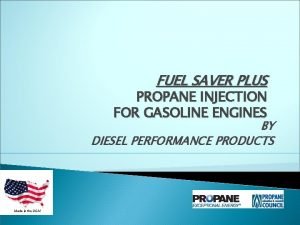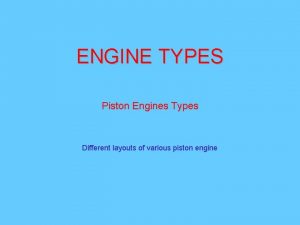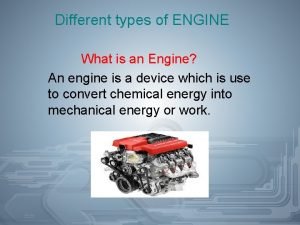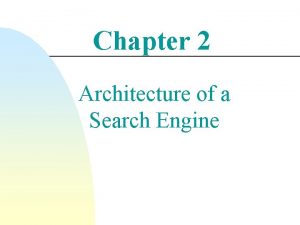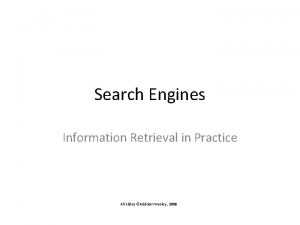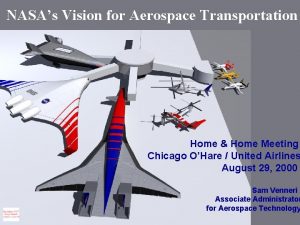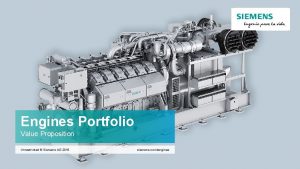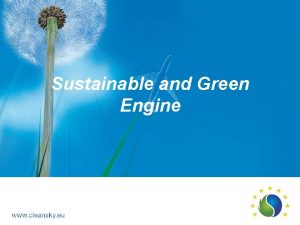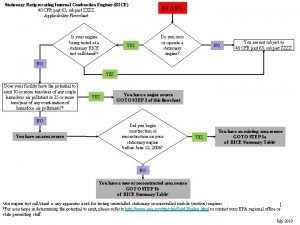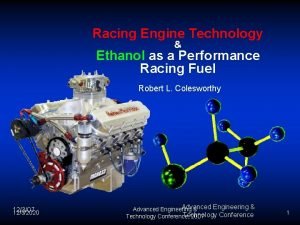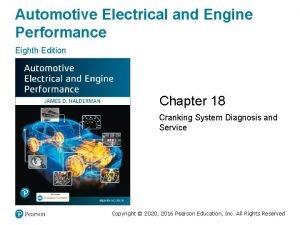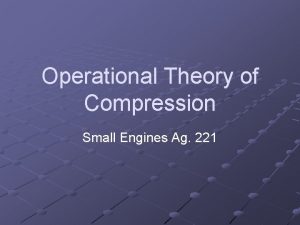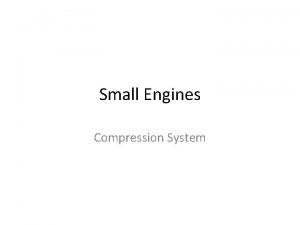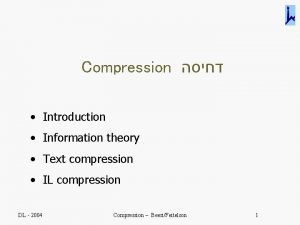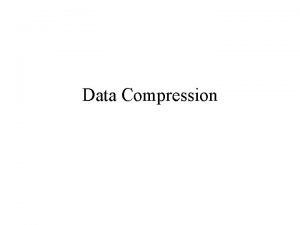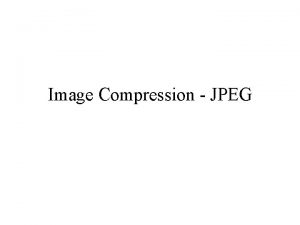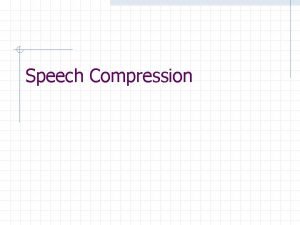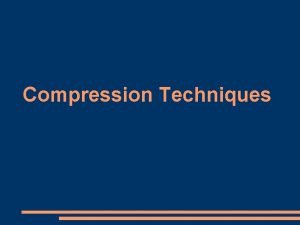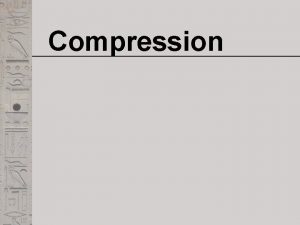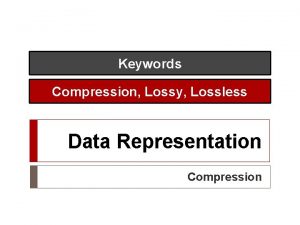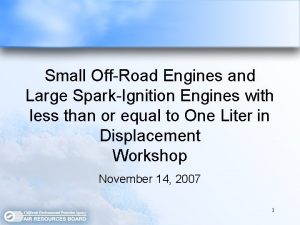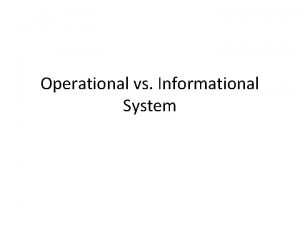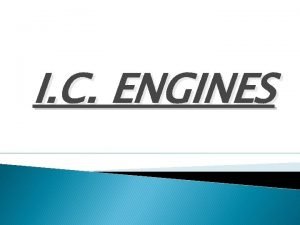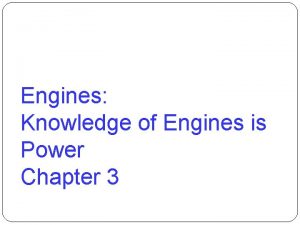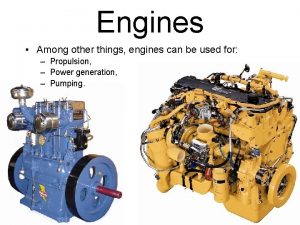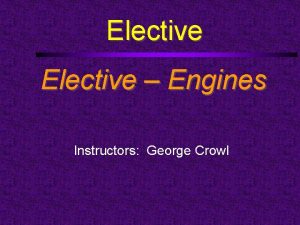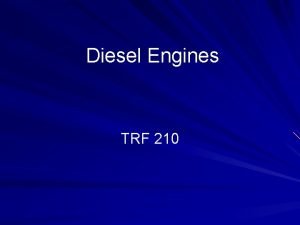Operational Theory of Compression Small Engines Ag 221





























- Slides: 29

Operational Theory of Compression Small Engines Ag. 221

Objectives Identify basic terms and definitions associated with compression List individual engine parts related to compression Describe, compare and contrast compression ratios Calculate engine displacement Test engine compression

Four Strokes

Compression Parts Cylinder

Compression Parts Piston Rings Compression Ring Scraper ring Piston oil ring

Compression Parts Valve stem Valve face

Compression Parts Valve seats Valve guides Cylinder head

Compression Parts Spark plug Head gasket

Temperature Multi cylinder engines are liquid cooled and temperature remains constant

Temperature Single cylinder engines are air cooled Cooling Fins Blower Housing Flywheel

Operating Temperature is affected by: ambient temperature n Temperature of the surroundings n If it’s a hot day, mowers run hotter

Operating Temperature is affected by: operating speed n Engines operating at high speed build up high amounts of heat

Operating Temperature is affected by: load put on the engine n If the engine is running hard under load, cooling cannot always keep up

Tolerances and Clearances Tolerances are when you torque (tighten) a bolt to a certain measurement, allowing for function when the metal expands. If space is not allowed, excess friction will cause overheating or worse!!

Clearance is the distance by which one object avoids hitting another

Tolerances/Clearances Tolerances and clearances must compensate for the entire range of temperatures n n What happens to metal when it gets hot? What is the result if connecting rod/rod journal clearance is not accurate?

Compression Test Briggs and Stratton does not have compression measurements for single cylinder engines n Why? Simple compression test: n n Spin the flywheel backwards quickly If the flywheel rebounds on the compression stroke, the engine has enough compression

Valves Most important factor in compression; Valves must seal to maintain compression Valves operate under the most severe conditions within an engine, especially the exhaust valve

Valves Exhaust valve is exposed to temperatures that may reach 1200° F. (red hot) n Exhaust valve is made of specialized steel in order to withstand the corrosive action and high temperature of exhaust gases

Valves in an engine operating at 3000 rpms (revolutions per minute) will open and close in 1/50 of a second

Valves Intake valve is cooled by the incoming air/fuel mixture

Valves Cylinder head and piston are exposed to the same heat n n Cylinder head is cooled by air from the flywheel fan across the cooling fins Piston is cooled by oil in the crank case

Valve Failure How does valve failure in a V-8 compare to valve failure in a single cylinder engine? Single – loss of horsepower or a cessation of function (it stops running all together!!!) Multi – fractional reduction in horsepower

Displacement The volume that is displaced by the piston The longer the stroke and the greater the bore (diameter of the cylinder) the greater the displacement Displacement indicates the relative size of the engine; horsepower is directly proportional to displacement Displacement is calculated by: displacement = (bore diameter 2/4) X ¶ X stroke length


Compression Ratio Compression ratio gives an efficiency measurement (higher compression = higher efficiency) A compression ratio of 8: 1 n Volume in cylinder is 8 times larger when the piston is at the bottom than when it is at the top Briggs and Stratton engines operate at a compression ratio of 5 -6: 1. .


High Octane Fuel Higher compression requires higher octane Premium fuels are more difficult to ignite therefore higher compression is necessary High octane fuels used in lower compression engines will not have enough compression to burn all the fuel Briggs motors are ran on low octane fuel

Knocking Low octane fuel used in high compression engines Compression ignites the fuel and starts the piston down prior to spark plug spark When spark occurs, any remaining fuel in the cylinder is ignited causing a knocking sound
 Troubleshooting small engines
Troubleshooting small engines Small gas engines chapter 8 answers
Small gas engines chapter 8 answers Medieval war machines
Medieval war machines Gopher search engine history
Gopher search engine history Search engines
Search engines Meta search engines compared
Meta search engines compared Open source search engines
Open source search engines Light vehicle diesel engines
Light vehicle diesel engines Propane injection
Propane injection Types of engine layouts
Types of engine layouts What is displacement in cars
What is displacement in cars Harper industries has $900 million of common equity
Harper industries has $900 million of common equity Search engines architecture
Search engines architecture Other search engines
Other search engines Search engines information retrieval in practice
Search engines information retrieval in practice Search engine architecture
Search engine architecture Aircraft engines
Aircraft engines Hz121800
Hz121800 Chapter 5 two-cycle and four-cycle engines answers
Chapter 5 two-cycle and four-cycle engines answers Avaya identity engines
Avaya identity engines Sage game engine
Sage game engine Subpart zzzz flowchart
Subpart zzzz flowchart Race engine technology
Race engine technology Search engines information retrieval in practice
Search engines information retrieval in practice Alliteration in keeping quiet
Alliteration in keeping quiet Automotive engines 8th edition
Automotive engines 8th edition Search engines
Search engines Link analysis
Link analysis Engines link analysis and
Engines link analysis and Yarn engines
Yarn engines
